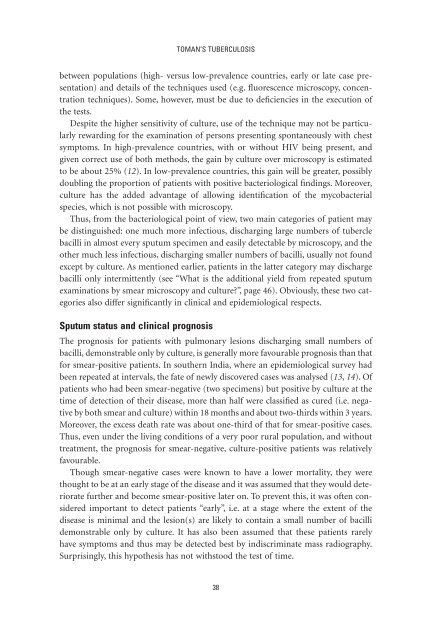toman's tuberculosis case detection, treatment and monitoring
toman's tuberculosis case detection, treatment and monitoring
toman's tuberculosis case detection, treatment and monitoring
Create successful ePaper yourself
Turn your PDF publications into a flip-book with our unique Google optimized e-Paper software.
TOMAN’S TUBERCULOSIS<br />
between populations (high- versus low-prevalence countries, early or late <strong>case</strong> presentation)<br />
<strong>and</strong> details of the techniques used (e.g. fluorescence microscopy, concentration<br />
techniques). Some, however, must be due to deficiencies in the execution of<br />
the tests.<br />
Despite the higher sensitivity of culture, use of the technique may not be particularly<br />
rewarding for the examination of persons presenting spontaneously with chest<br />
symptoms. In high-prevalence countries, with or without HIV being present, <strong>and</strong><br />
given correct use of both methods, the gain by culture over microscopy is estimated<br />
to be about 25% (12). In low-prevalence countries, this gain will be greater, possibly<br />
doubling the proportion of patients with positive bacteriological findings. Moreover,<br />
culture has the added advantage of allowing identification of the mycobacterial<br />
species, which is not possible with microscopy.<br />
Thus, from the bacteriological point of view, two main categories of patient may<br />
be distinguished: one much more infectious, discharging large numbers of tubercle<br />
bacilli in almost every sputum specimen <strong>and</strong> easily detectable by microscopy, <strong>and</strong> the<br />
other much less infectious, discharging smaller numbers of bacilli, usually not found<br />
except by culture. As mentioned earlier, patients in the latter category may discharge<br />
bacilli only intermittently (see “What is the additional yield from repeated sputum<br />
examinations by smear microscopy <strong>and</strong> culture?”, page 46). Obviously, these two categories<br />
also differ significantly in clinical <strong>and</strong> epidemiological respects.<br />
Sputum status <strong>and</strong> clinical prognosis<br />
The prognosis for patients with pulmonary lesions discharging small numbers of<br />
bacilli, demonstrable only by culture, is generally more favourable prognosis than that<br />
for smear-positive patients. In southern India, where an epidemiological survey had<br />
been repeated at intervals, the fate of newly discovered <strong>case</strong>s was analysed (13, 14). Of<br />
patients who had been smear-negative (two specimens) but positive by culture at the<br />
time of <strong>detection</strong> of their disease, more than half were classified as cured (i.e. negative<br />
by both smear <strong>and</strong> culture) within 18 months <strong>and</strong> about two-thirds within 3 years.<br />
Moreover, the excess death rate was about one-third of that for smear-positive <strong>case</strong>s.<br />
Thus, even under the living conditions of a very poor rural population, <strong>and</strong> without<br />
<strong>treatment</strong>, the prognosis for smear-negative, culture-positive patients was relatively<br />
favourable.<br />
Though smear-negative <strong>case</strong>s were known to have a lower mortality, they were<br />
thought to be at an early stage of the disease <strong>and</strong> it was assumed that they would deteriorate<br />
further <strong>and</strong> become smear-positive later on. To prevent this, it was often considered<br />
important to detect patients “early”, i.e. at a stage where the extent of the<br />
disease is minimal <strong>and</strong> the lesion(s) are likely to contain a small number of bacilli<br />
demonstrable only by culture. It has also been assumed that these patients rarely<br />
have symptoms <strong>and</strong> thus may be detected best by indiscriminate mass radiography.<br />
Surprisingly, this hypothesis has not withstood the test of time.<br />
38

















